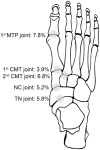Foot osteoarthritis: latest evidence and developments
- PMID: 29619094
- PMCID: PMC5871064
- DOI: 10.1177/1759720X17753337
Foot osteoarthritis: latest evidence and developments
Abstract
Foot osteoarthritis (OA) is a common problem in older adults yet is under-researched compared to knee or hand OA. Most existing studies focus on the first metatarsophalangeal joint, with evidence relating to midfoot OA being particularly sparse. Symptomatic radiographic foot OA affects 17% of adults aged 50 years and over. The first metatarsophalangeal joint is most commonly affected, followed by the second cuneometatarsal and talonavicular joints. Epidemiological studies suggest the existence of distinct first metatarsophalangeal joint and polyarticular phenotypes, which have differing clinical and risk factor profiles. There are few randomized controlled trials in foot OA. Existing trials provide some evidence of the effectiveness for pain relief of physical therapy, rocker-sole shoes, foot orthoses and surgical interventions in first metatarsophalangeal joint OA and prefabricated orthoses in midfoot OA. Prospective epidemiological studies and randomized trials are needed to establish the incidence, progression and prognosis of foot OA and determine the effectiveness of both commonly used and more novel interventions.
Keywords: epidemiology; foot osteoarthritis; randomized controlled trials; treatment.
Conflict of interest statement
Conflict of interest statement: The authors declare that there is no conflict of interest.
Figures



References
-
- WHO Scientific Group on the Burden of Musculoskeletal Conditions at the Start of the New Millennium. The burden of musculoskeletal conditions at the start of the new millennium. World Health Organ Tech Rep Ser 2003; 919: i–x, 1–218. - PubMed
Publication types
Grants and funding
LinkOut - more resources
Full Text Sources
Other Literature Sources

